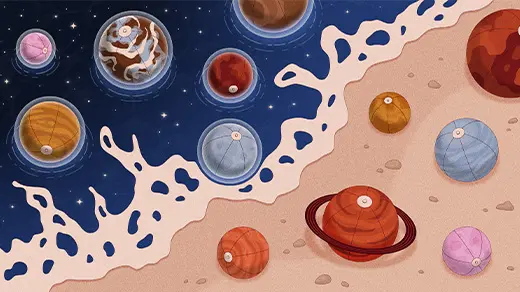A World Without Clouds
Michelle Yun/Quanta Magazine; source: cbglp2
On a 1987 voyage to the Antarctic, the paleoceanographer James Kennett and his crew dropped anchor in the Weddell Sea, drilled into the seabed, and extracted a vertical cylinder of sediment. In an inch-thick layer of plankton fossils and other detritus buried more than 500 feet deep, they found a disturbing clue about the planet’s past that could spell disaster for the future.
Lower in the sediment core, fossils abounded from 60 plankton species. But in that thin cross-section from about 56 million years ago, the number of species dropped to 17. And the planktons’ oxygen and carbon isotope compositions had dramatically changed. Kennett and his student Lowell Stott deduced from the anomalous isotopes that carbon dioxide had flooded the air, causing the ocean to rapidly acidify and heat up, in a process similar to what we are seeing today.
While those 17 kinds of plankton were sinking through the warming waters and settling on the Antarctic seabed, a tapir-like creature died in what is now Wyoming, depositing a tooth in a bright-red layer of sedimentary rock coursing through the badlands of the Bighorn Basin. In 1992, the finder of the tooth fossil, Phil Gingerich, and collaborators Jim Zachos and Paul Koch reported the same isotope anomalies in its enamel that Kennett and Stott had presented in their ocean findings a year earlier. The prehistoric mammal had also been breathing CO2-flooded air.
More data points surfaced in China, then Europe, then all over. A picture emerged of a brief, cataclysmic hot spell 56 million years ago, now known as the Paleocene-Eocene Thermal Maximum (PETM). After heat-trapping carbon leaked into the sky from an unknown source, the planet, which was already several degrees Celsius hotter than it is today, gained an additional 6 degrees. The ocean turned jacuzzi-hot near the equator and experienced mass extinctions worldwide. On land, primitive monkeys, horses and other early mammals marched northward, following vegetation to higher latitudes. The mammals also miniaturized over generations, as leaves became less nutritious in the carbonaceous air. Violent storms ravaged the planet; the geologic record indicates flash floods and protracted droughts. As Kennett put it, “Earth was triggered, and all hell broke loose.”
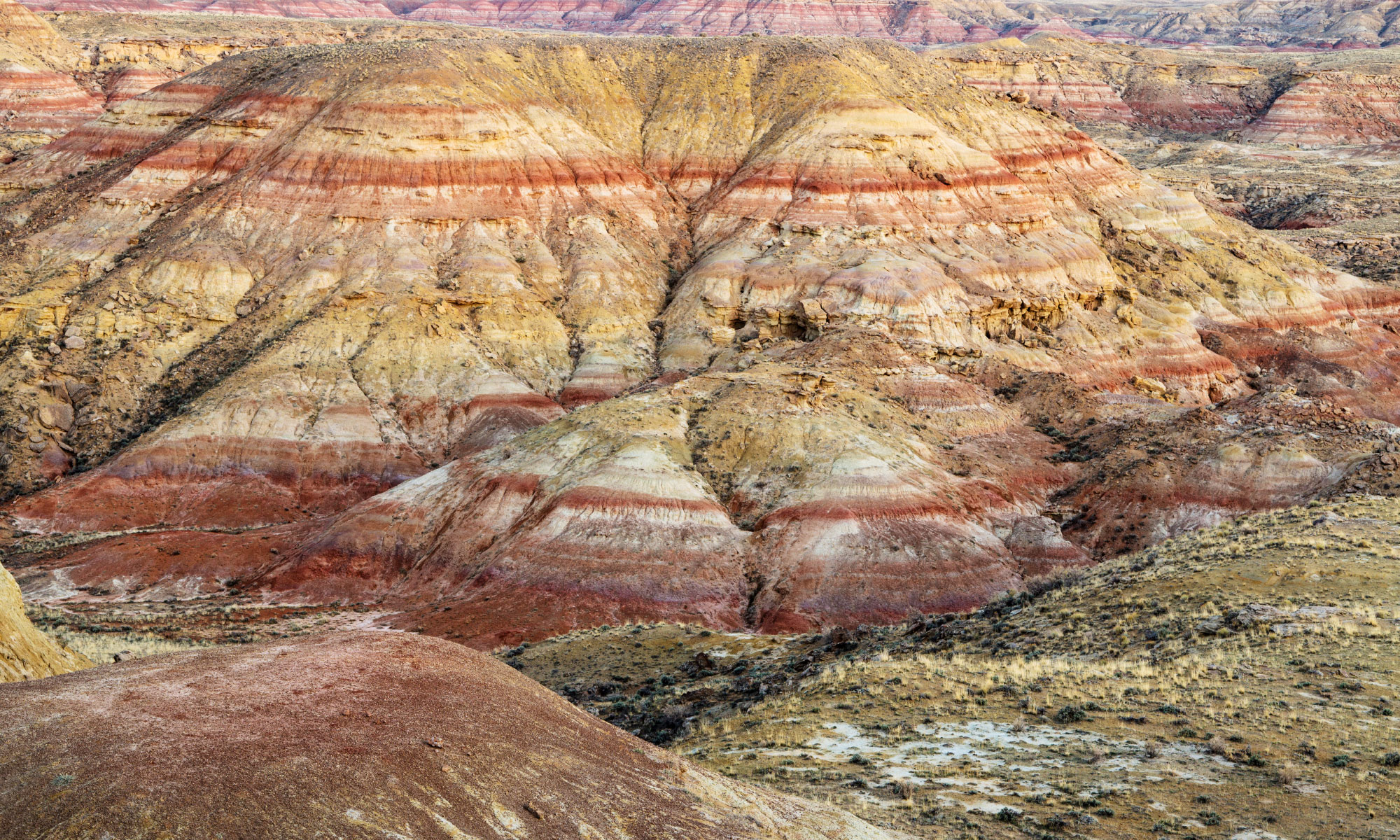
A bright-red stratum of sedimentary rock coursing through the badlands in Wyoming’s Bighorn Basin yielded some of the first fossil evidence of an extreme global warming event 56 million years ago.
The PETM doesn’t only provide a past example of CO2-driven climate change; scientists say it also points to an unknown factor that has an outsize influence on Earth’s climate. When the planet got hot, it got really hot. Ancient warming episodes like the PETM were always far more extreme than theoretical models of the climate suggest they should have been. Even after accounting for differences in geography, ocean currents and vegetation during these past episodes, paleoclimatologists find that something big appears to be missing from their models — an X-factor whose wild swings leave no trace in the fossil record.
Evidence is mounting in favor of the answer that experts have long suspected but have only recently been capable of exploring in detail. “It’s quite clear at this point that the answer is clouds,” said Matt Huber, a paleoclimate modeler at Purdue University.
Clouds currently cover about two-thirds of the planet at any moment. But computer simulations of clouds have begun to suggest that as the Earth warms, clouds become scarcer. With fewer white surfaces reflecting sunlight back to space, the Earth gets even warmer, leading to more cloud loss. This feedback loop causes warming to spiral out of control.
For decades, rough calculations have suggested that cloud loss could significantly impact climate, but this concern remained speculative until the last few years, when observations and simulations of clouds improved to the point where researchers could amass convincing evidence.
Now, new findings reported today in the journal Nature Geoscience make the case that the effects of cloud loss are dramatic enough to explain ancient warming episodes like the PETM — and to precipitate future disaster. Climate physicists at the California Institute of Technology performed a state-of-the-art simulation of stratocumulus clouds, the low-lying, blankety kind that have by far the largest cooling effect on the planet. The simulation revealed a tipping point: a level of warming at which stratocumulus clouds break up altogether. The disappearance occurs when the concentration of CO2 in the simulated atmosphere reaches 1,200 parts per million — a level that fossil fuel burning could push us past in about a century, under “business-as-usual” emissions scenarios. In the simulation, when the tipping point is breached, Earth’s temperature soars 8 degrees Celsius, in addition to the 4 degrees of warming or more caused by the CO2 directly.
Once clouds go away, the simulated climate “goes over a cliff,” said Kerry Emanuel, a climate scientist at the Massachusetts Institute of Technology. A leading authority on atmospheric physics, Emanuel called the new findings “very plausible,” though, as he noted, scientists must now make an effort to independently replicate the work.
To imagine 12 degrees of warming, think of crocodiles swimming in the Arctic and of the scorched, mostly lifeless equatorial regions during the PETM. If carbon emissions aren’t curbed quickly enough and the tipping point is breached, “that would be truly devastating climate change,” said Caltech’s Tapio Schneider, who performed the new simulation with Colleen Kaul and Kyle Pressel.
Huber said the stratocumulus tipping point helps explain the volatility that’s evident in the paleoclimate record. He thinks it might be one of many unknown instabilities in Earth’s climate. “Schneider and co-authors have cracked open Pandora’s box of potential climate surprises,” he said, adding that, as the mechanisms behind vanishing clouds become clear, “all of a sudden this enormous sensitivity that is apparent from past climates isn’t something that’s just in the past. It becomes a vision of the future.”
The Cloud Question
Clouds come in diverse shapes — sky-filling stratus, popcorn-puff cumulus, wispy cirrus, anvil-shaped nimbus and hybrids thereof — and span many physical scales. Made of microscopic droplets, they measure miles across and, collectively, cover most of the Earth’s surface. By blocking sunlight from reaching the surface, clouds cool the planet by several crucial degrees. And yet, they are insubstantial, woven into greatness by complicated physics. If the planet’s patchy white veil of clouds descended to the ground, it would make a watery sheen no thicker than a hair.
Clouds seem simple at first: They form when warm, humid air rises and cools. The water vapor in the air condenses around dust grains, sea salt or other particles, forming droplets of liquid water or ice — “cloud droplets.” But the picture grows increasingly complicated as heat, evaporation, turbulence, radiation, wind, geography and myriad other factors come into play.
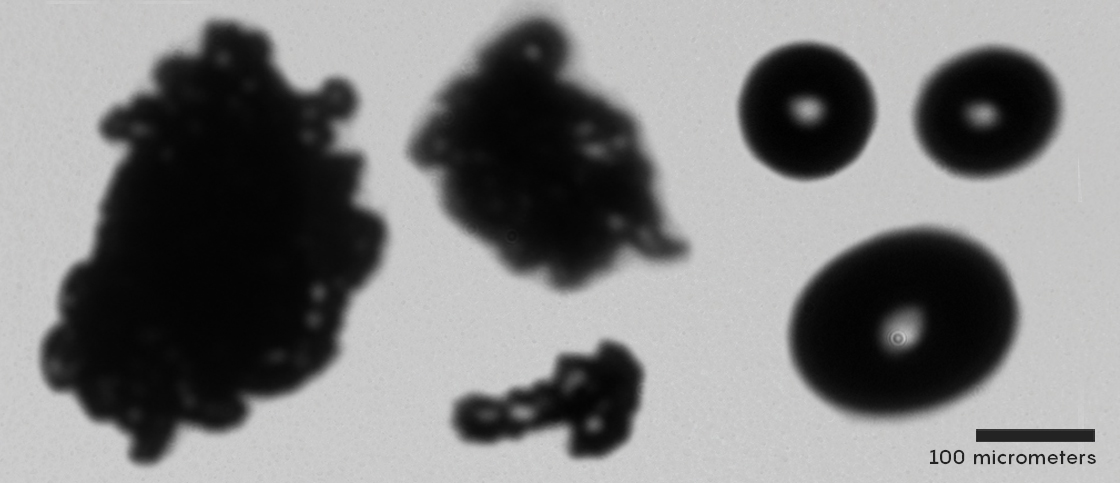
These irregularly shaped cloud droplets made of ice (left) and spherical cloud droplets made of supercooled liquid water were laser-imaged during a 2018 research flight through stratocumulus clouds over the Southern Ocean.
Courtesy of Dr. Emma Järvinen and Dr. Martin Schnaiter (KIT and schnaiTEC, Germany)
Physicists have struggled since the 1960s to understand how global warming will affect the many different kinds of clouds, and how that will influence global warming in turn. For decades, clouds have been seen as by far the biggest source of uncertainty over how severe global warming will be — other than what society will do to reduce carbon emissions.
Kate Marvel contemplates the cloud question at the NASA Goddard Institute for Space Studies in New York City. Last spring, in her office several floors above Tom’s Restaurant on the Upper West Side, Marvel, wearing a cloud-patterned scarf, pointed to a plot showing the range of predictions made by different global climate models. The 30 or so models, run by climate research centers around the world, program in all the known factors to predict how much Earth’s temperature will increase as the CO2 level ticks up.
Each climate model solves a set of equations on a spherical grid representing Earth’s atmosphere. A supercomputer is used to evolve the grid of solutions forward in time, indicating how air and heat flow through each of the grid cells and circulate around the planet. By adding carbon dioxide and other heat-trapping greenhouse gases to the simulated atmosphere and seeing what happens, scientists can predict Earth’s climate response. All the climate models include Earth’s ocean and wind currents and incorporate most of the important climate feedback loops, like the melting of the polar ice caps and the rise in humidity, which both exacerbate global warming. The models agree about most factors but differ greatly in how they try to represent clouds.
The least sensitive climate models, which predict the mildest reaction to increasing CO2, find that Earth will warm 2 degrees Celsius if the atmospheric CO2 concentration doubles relative to preindustrial times, which is currently on track to happen by about 2050. (The CO2 concentration was 280 parts per million before fossil fuel burning began, and it’s above 410 ppm now. So far, the average global temperature has risen 1 degree Celsius.) But the 2-degree prediction is the best-case scenario. “The thing that really freaks people out is this upper end here,” Marvel said, indicating projections of 4 or 5 degrees of warming in response to the doubling of CO2. “To put that in context, the difference between now and the last ice age was 4.5 degrees.”
The huge range in the models’ predictions chiefly comes down to whether they see clouds blocking more or less sunlight in the future. As Marvel put it, “You can fairly confidently say that the model spread in climate sensitivity is basically just a model spread in what clouds are going to do.”
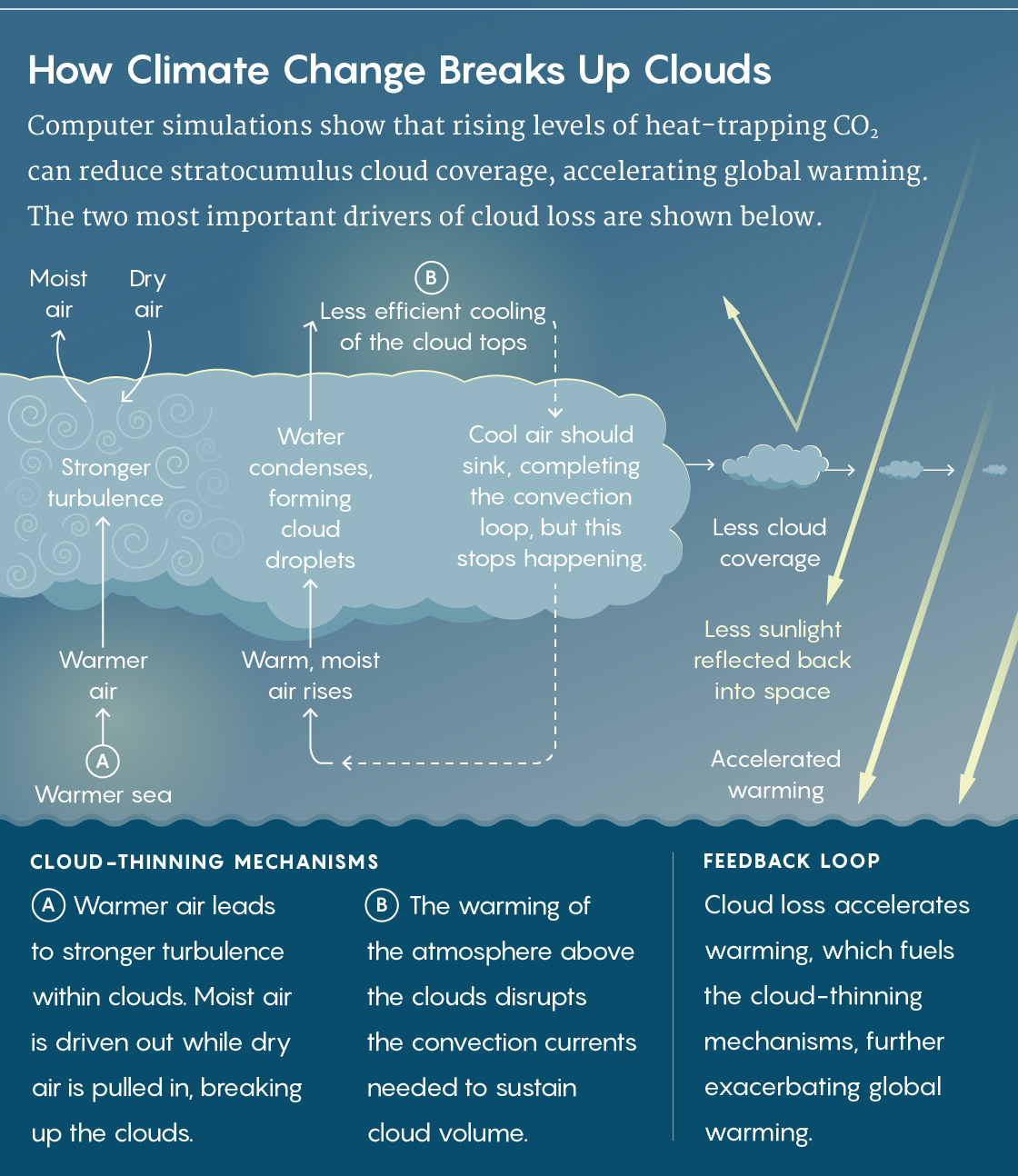
Lucy Reading-Ikkanda/Quanta Magazine
The problem is that, in computer simulations of the global climate, today’s supercomputers cannot resolve grid cells that are smaller than about 100 kilometers by 100 kilometers in area. But clouds are often no more than a few kilometers across. Physicists therefore have to simplify or “parameterize” clouds in their global models, assigning an overall level of cloudiness to each grid cell based on other properties, like temperature and humidity.
But clouds involve the interplay of so many mechanisms that it’s not obvious how best to parameterize them. The warming of the Earth and sky strengthens some mechanisms involved in cloud formation, while also fueling other forces that break clouds up. Global climate models that predict 2 degrees of warming in response to doubling CO2 generally also see little or no change in cloudiness. Models that project a rise of 4 or more degrees forecast fewer clouds in the coming decades.
The climatologist Michael Mann, director of the Earth System Science Center at Pennsylvania State University, said that even 2 degrees of warming will cause “considerable loss of life and suffering.” He said it will kill coral reefs whose fish feed millions, while also elevating the risk of damaging floods, wildfires, droughts, heat waves, and hurricanes and causing “several feet of sea-level rise and threats to the world’s low-lying island nations and coastal cities.”
At the 4-degree end of the range, we would see not only “the destruction of the world’s coral reefs, massive loss of animal species, and catastrophic extreme weather events,” Mann said, but also “meters of sea-level rise that would challenge our capacity for adaptation. It would mean the end of human civilization in its current form.”
It is difficult to imagine what might happen if, a century or more from now, stratocumulus clouds were to suddenly disappear altogether, initiating something like an 8-degree jump on top of the warming that will already have occurred. “I hope we’ll never get there,” Tapio Schneider said in his Pasadena office last year.
The Simulated Sky
In the last decade, advances in supercomputing power and new observations of actual clouds have attracted dozens of researchers like Schneider to the problem of global warming’s X-factor. Researchers are now able to model cloud dynamics at high resolution, generating patches of simulated clouds that closely match real ones. This has allowed them to see what happens when they crank up the CO2.
First, physicists came to grips with high clouds — the icy, wispy ones like cirrus clouds that are miles high. By 2010, work by Mark Zelinka of Lawrence Livermore National Laboratory and others convincingly showed that as Earth warms, high clouds will move higher in the sky and also shift toward higher latitudes, where they won’t block as much direct sunlight as they do nearer the equator. This is expected to slightly exacerbate warming, and all global climate models have integrated this effect.
But vastly more important and more challenging than high clouds are the low, thick, turbulent ones — especially the stratocumulus variety. Bright-white sheets of stratocumulus cover a quarter of the ocean, reflecting 30 to 70 percent of the sunlight that would otherwise be absorbed by the dark waves below. Simulating stratocumulus clouds requires immense computing power because they contain turbulent eddies of all sizes.
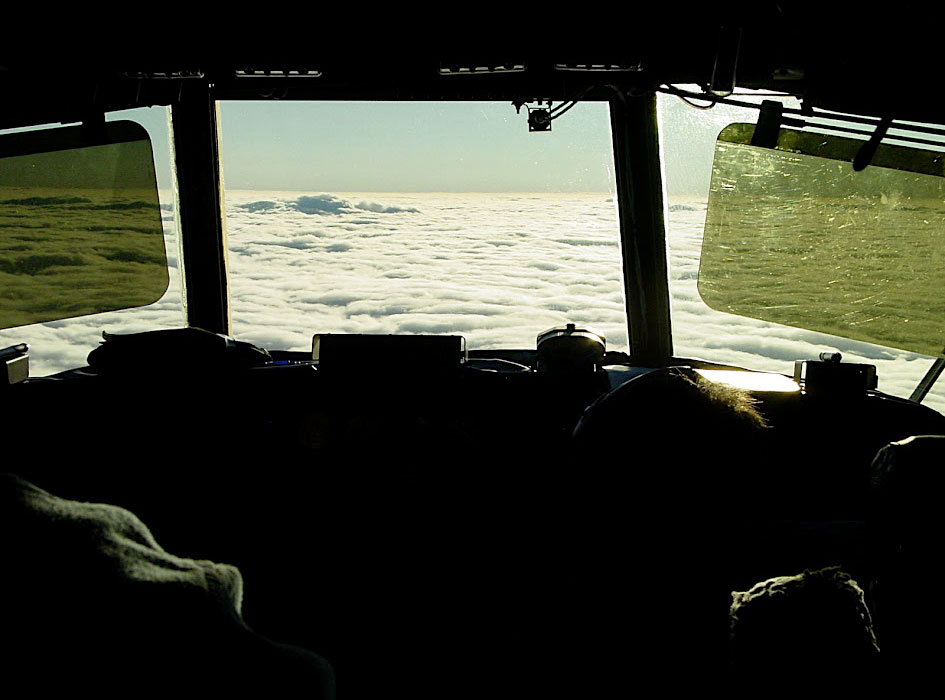
A research aircraft flying through stratocumulus clouds off the coast of Chile during a 2008 mission to gather data about the interactions between clouds, aerosols, atmospheric boundary layers, wind currents and other aspects of the Southeast Pacific climate.
Robert Wood
Chris Bretherton, an atmospheric scientist and mathematician at the University of Washington, performed some of the first simulations of these clouds combined with idealized climate models in 2013 and 2014. He and his collaborators modeled a small patch of stratocumulus and found that as the sea surface below it warmed under the influence of CO2, the cloud became thinner. That work and other findings — such as NASA satellite data indicating that warmer years are less cloudy than colder years — began to suggest that the least sensitive global climate models, the ones predicting little change in cloud cover and only 2 degrees of warming, probably aren’t right.
Bretherton, whom Schneider calls “the smartest person we have in this area,” doesn’t only develop some of the best simulations of stratocumulus clouds; he and his team also fly through the actual clouds, dangling instruments from airplane wings to measure atmospheric conditions and bounce lasers off of cloud droplets.
In the Socrates mission last winter, Bretherton hopped on a government research plane and flew through stratocumulus clouds over the Southern Ocean between Tasmania and Antarctica. Global climate models tend to greatly underestimate the cloudiness of this region, and this makes the models relatively insensitive to possible changes in cloudiness. Bretherton and his team set out to investigate why Southern Ocean clouds are so abundant. Their data indicate that the clouds consist primarily of supercooled water droplets rather than ice particles, as climate modelers had long assumed. Liquid-water droplets stick around longer than ice droplets (which are bigger and more likely to fall as rain), and this seems to be why the region is cloudier than global climate models predict. Adjusting the models to reflect the findings will make them more sensitive to cloud loss in this region as the planet heats up. This is one of several lines of evidence, Bretherton said, “that would favor the range of predictions that’s 3 to 5 degrees, not the 2- to 3-degree range.”
Schneider’s new simulation with Kaul and Pressel improved on Bretherton’s earlier work primarily by connecting what happens in a small patch of stratocumulus cloud to a simple model of the rest of Earth’s climate. This allowed them to investigate for the first time how these clouds not only respond to, but also affect, the global temperature, in a potential feedback loop.



California Institute of Technology (Schneider); Courtesy of Colleen Kaul; Courtesy of Kyle Pressel
Their simulation, which ran for 2 million core-hours on supercomputers in Switzerland and California, modeled a roughly 5-by-5-kilometer patch of stratocumulus cloud much like the clouds off the California coast. As the CO2 level ratchets up in the simulated sky and the sea surface heats up, the dynamics of the cloud evolve. The researchers found that the tipping point occurs, and stratocumulus clouds suddenly disappear, because of two dominant factors that work against their formation. First, when higher CO2 levels make Earth’s surface and sky hotter, the extra heat drives stronger turbulence inside the clouds. The turbulence mixes moist air near the top of the cloud, pushing it up and out through an important boundary layer that caps stratocumulus clouds, while drawing dry air in from above. Entrainment, as this is called, works to break up the cloud.
Secondly, as the greenhouse effect makes the upper atmosphere warmer and thus more humid, the cooling of the tops of stratocumulus clouds from above becomes less efficient. This cooling is essential, because it causes globs of cold, moist air at the top of the cloud to sink, making room for warm, moist air near Earth’s surface to rise into the cloud and become it. When cooling gets less effective, stratocumulus clouds grow thin.
Countervailing forces and effects eventually get overpowered; when the CO2 level reaches about 1,200 parts per million in the simulation — which could happen in 100 to 150 years, if emissions aren’t curbed — more entrainment and less cooling conspire to break up the stratocumulus cloud altogether.
To see how the loss of clouds would affect the global temperature, Schneider and colleagues inverted the approach of global climate models, simulating their cloud patch at high resolution and parameterizing the rest of the world outside that box. They found that, when the stratocumulus clouds disappeared in the simulation, the enormous amount of extra heat absorbed into the ocean increased its temperature and rate of evaporation. Water vapor has a greenhouse effect much like CO2, so more water vapor in the sky means that more heat will be trapped at the planet’s surface. Extrapolated to the entire globe, the loss of low clouds and rise in water vapor leads to runaway warming — the dreaded 8-degree jump. After the climate has made this transition and water vapor saturates the air, ratcheting down the CO2 won’t bring the clouds back. “There’s hysteresis,” Schneider said, where the state of the system depends on its history. “You need to reduce CO2 to concentrations around present day, even slightly below, before you form stratocumulus clouds again.”
Paleoclimatologists said this hysteresis might explain other puzzles about the paleoclimate record. During the Pliocene, 3 million years ago, the atmospheric CO2 level was 400 ppm, similar to today, but Earth was 4 degrees hotter. This might be because we were cooling down from a much warmer, perhaps largely cloudless period, and stratocumulus clouds hadn’t yet come back.
Past, Present and Future
Schneider emphasized an important caveat to the study, which will need to be addressed by future work: The simplified climate model he and his colleagues created assumed that global wind currents would stay as they are now. However, there is some evidence that these circulations might weaken in a way that would make stratocumulus clouds more robust, raising the threshold for their disappearance from 1,200 ppm to some higher level. Other changes could do the opposite, or the tipping point could vary by region.
To better “capture the heterogeneity” of the global system, Schneider said, researchers will need to use many simulations of cloud patches to calibrate a global climate model. “What I would love to do, and what I hope we’ll get a chance to do, is embed many, many of these [high-resolution] simulations in a global climate model, maybe tens of thousands, and then run a global climate simulation that interacts with” all of them, he said. Such a setup would enable a more precise prediction of the stratocumulus tipping point or points.
There’s a long way to go before we reach 1,200 parts per million, or thereabouts. Ultimate disaster can be averted if net carbon emissions can be reduced to zero — which doesn’t mean humans can’t release any carbon into the sky. We currently pump out 10 billion tons of it each year, and scientists estimate that Earth can absorb about 2 billion tons of it a year, in addition to what’s naturally emitted and absorbed. If fossil fuel emissions can be reduced to 2 billion tons annually through the expansion of solar, wind, nuclear and geothermal energy, changes in the agricultural sector, and the use of carbon-capture technology, anthropogenic global warming will slow to a halt.
What does Schneider think the future will bring? Sitting in his office with his laptop screen open to a mesmerizing simulation of roiling clouds, he said, “I am pretty — fairly — optimistic, simply because I think solar power has gotten so much cheaper. It’s not that far away from the cost curve for producing electricity from solar power crossing the fossil fuel cost curve. And once it crosses, there will be an exponential transformation of entire industries.”
Kerry Emanuel, the MIT climate scientist, noted that possible economic collapse caused by nearer-term effects of climate change might also curtail carbon emissions before the stratocumulus tipping point is reached.
But other unforeseen changes and climate tipping points could accelerate us toward the cliff. “I’m worried,” said Kennett, the pioneering paleoceanographer who discovered the PETM and unearthed evidence of many other tumultuous periods in Earth’s history. “Are you kidding? As far as I’m concerned, global warming is the major issue of our time.”
During the PETM, mammals, newly ascendant after the dinosaurs’ downfall, actually thrived. Their northward march led them to land bridges that allowed them to fan out across the globe, filling ecological niches and spreading south again as the planet reabsorbed the excess CO2 in the sky and cooled over 200,000 years. However, their story is hardly one we can hope to emulate. One difference, scientists say, is that Earth was much warmer then to begin with, so there were no ice caps to melt and accelerate the warming and sea-level rise.
“The other big difference,” said the climatologist Gavin Schmidt, director of the Goddard Institute, “is, we’re here, and we’re adapted to the climate we have. We built our cities all the way around the coasts; we’ve built our agricultural systems expecting the rain to be where it is and the dry areas to be where they are.” And national borders are where they are. “We’re not prepared for those things to shift,” he said.
This article was reprinted on Wired.com.



